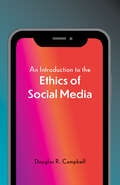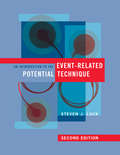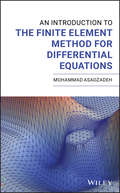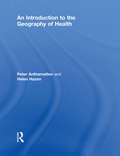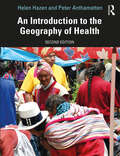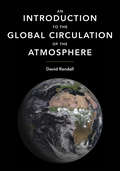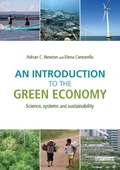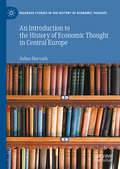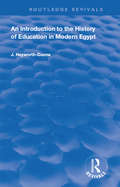- Table View
- List View
An Introduction to the Ethics of Social Media
by Douglas Campbell"Doug Campbell lays out a comprehensive and fair-minded account of both the benefits and the drawbacks of social media for our era. He attaches these evaluations to both the individual and to society as a whole. The case studies are compelling and exhibit a keen awareness of the current moment. How should we live, now that many or even most of us are at least partially online? Campbell addresses this question from the point of view of privacy, attention, politics, misinformation, online ostracism, online friendship, and the potential benefits of simply quitting social media or at least some of its more pernicious platforms. Along the way, Campbell ties his discussions back to philosophical concerns raised by Plato, Aristotle, and Xunzi, among others. He also connects his discussion with recent work in feminist philosophy. And each chapter concludes with a succinct definition of key terms and suggested case studies and discussion topics that will engage students at all levels. An impressive accomplishment, and one that deserves a place in the classroom." —Mark Alfano, Macquarie University
An Introduction to the Event-Related Potential Technique, second edition
by Steven J. LuckAn essential guide to designing, conducting, and analyzing event-related potential (ERP) experiments, completely updated for this edition.The event-related potential (ERP) technique, in which neural responses to specific events are extracted from the EEG, provides a powerful noninvasive tool for exploring the human brain. This volume describes practical methods for ERP research along with the underlying theoretical rationale. It offers researchers and students an essential guide to designing, conducting, and analyzing ERP experiments. This second edition has been completely updated, with additional material, new chapters, and more accessible explanations. Freely available supplementary material, including several online-only chapters, offer expanded or advanced treatment of selected topics.The first half of the book presents essential background information, describing the origins of ERPs, the nature of ERP components, and the design of ERP experiments. The second half of the book offers a detailed treatment of the main steps involved in conducting ERP experiments, covering such topics as recording the EEG, filtering the EEG and ERP waveforms, and quantifying amplitudes and latencies. Throughout, the emphasis is on rigorous experimental design and relatively simple analyses. New material in the second edition includes entire chapters devoted to components, artifacts, measuring amplitudes and latencies, and statistical analysis; updated coverage of recording technologies; concrete examples of experimental design; and many more figures. Online chapters cover such topics as overlap, localization, writing and reviewing ERP papers, and setting up and running an ERP lab.
An Introduction to the Finite Element Method for Differential Equations
by Mohammad AsadzadehMaster the finite element method with this masterful and practical volume An Introduction to the Finite Element Method (FEM) for Differential Equations provides readers with a practical and approachable examination of the use of the finite element method in mathematics. Author Mohammad Asadzadeh covers basic FEM theory, both in one-dimensional and higher dimensional cases. The book is filled with concrete strategies and useful methods to simplify its complex mathematical contents. Practically written and carefully detailed, An Introduction to the Finite Element Method covers topics including: An introduction to basic ordinary and partial differential equations The concept of fundamental solutions using Green's function approaches Polynomial approximations and interpolations, quadrature rules, and iterative numerical methods to solve linear systems of equations Higher-dimensional interpolation procedures Stability and convergence analysis of FEM for differential equations This book is ideal for upper-level undergraduate and graduate students in natural science and engineering. It belongs on the shelf of anyone seeking to improve their understanding of differential equations.
An Introduction to the Geography of Health
by Peter Anthamatten Helen HazenHealth issues such as the emergence of infectious diseases, the potential influence of global warming on human health, and the escalating strain of increasing longevity and chronic conditions on healthcare systems are of growing importance in an increasingly peopled and interconnected world. A geographic approach to the study of health offers a critical perspective to these issues, considering how changing relationships between people and their environments influence human health. An Introduction to the Geography of Health provides an accessible introduction to this rapidly growing field, covering theoretical and methodological background. The text is divided into three sections which consider distinct approaches and techniques related to health geographies. Section one introduces ecological approaches, with a focus on how natural and built environments affect human health. For instance, how have irrigation projects influenced the spread of water-borne diseases? How can modern healthcare settings, such as hospitals, affect the spread and evolution of pathogens? Section two discusses social aspects of health and healthcare, considering health as not merely a biological interaction between a pathogen and human host, but as a process that is situated among social factors which ultimately drive who suffers from what, and where disease occurs. Section three then considers spatial techniques and approaches to exploring health, giving special focus to the growing role of cartography and geographic information systems (GIS) in the study of health. This clearly written text contains a range of pedagogical features including a wealth of global case studies, discussion questions and suggestions for further reading at the end of each chapter, a colour plate section and over eighty diagrams and figures. The accompanying website also provides presentations, exercises, further resources, and tables and figures. This book is an essential introductory text for undergraduate students studying Geography, Health and Social Studies.
An Introduction to the Geography of Health
by Peter Anthamatten Helen HazenIn the second edition of An Introduction to the Geography of Health, Hazen and Anthamatten explore the ways in which geographic ideas and approaches can inform our understanding of health. The book’s focus on a broad range of physical and social factors that drive health in places and spaces offers students and scholars an important holistic perspective on the study of health in the modern era. In this edition, the authors have restructured the book to emphasize the theoretical significance of ecological and social approaches to health. Spatial methods are now reinforced throughout the book and other qualitative and quantitative methods are discussed in greater depth. Data and examples are used extensively to illustrate key points and have been updated throughout, including several new extended case studies such as water contamination in Flint Michigan, microplastics pollution, West Africa’s Ebola crisis, and the Zika epidemic. The book contains over one hundred figures, including new and updated maps, data graphics, and photos. The book is designed to be used as the core text for a health geography course for undergraduate and lower-level graduate students, and is relevant to students of biology, medicine, entomology, social science, urban planning, and public health.
An Introduction to the Geopolitics of Conflict, Nationalism, and Reconciliation in Ireland (Routledge Geopolitics Series)
by Kara E. DempseyThis book examines ethnoterritorial conflict and reconciliation in Ireland from the 1916 Rising to Brexit (2021), including the production and consequences of the island’s two distinct political units. Highlighting key geographic themes of bordering, unity, division, and national narratives, it explores how geopolitical space has been employed over time to (re)define divided national allegiances throughout Ireland and within Irish–British relations. The analysis draws from in-depth interviews and archival research, and spans supranational, state, municipal, neighborhood, and individual scales. The book pays particular attention to uneven power structures, statecraft, perceived truths, lived experiences, reconciliation efforts, and renegotiations of national narratives in the production of symbolic landscapes, divided cities, and "shared" space. An Introduction to the Geopolitics of Conflict, Nationalism, and Reconciliation in Ireland provides readers with an analysis of geopolitical power relations and different spatial productions of conflict and peacebuilding in Ireland. Offering deeper understanding of these historic and contemporary geopolitical intersections, this book makes a valuable contribution to the fields of Political Geography, Border Studies, Irish Studies, European Studies, International Relations, Cultural Geography, and Regional Studies.
An Introduction to the Global Circulation of the Atmosphere
by David RandallThis is a graduate-level textbook on the global circulation of the Earth's atmosphere--the large-scale system of winds by which energy is transported around the planet, from the tropical latitudes to the poles. Written by David Randall, one of the world's foremost experts on the subject, it is the most comprehensive textbook on the topic. Intended for Earth science students who have completed some graduate-level coursework in atmospheric dynamics, the book will help students build on that foundation, preparing them for research in the field.The book describes the many phenomena of the circulation and explains them in terms of current ideas from fluid dynamics and thermodynamics, with frequent use of isentropic coordinates and using the methods of vector calculus. It emphasizes the key roles of water vapor and clouds, includes detailed coverage of energy flows and transformations, and pays close attention to scale interactions. The book also describes the major historical contributions of key scientists, giving a human dimension to the narrative, and it closes with a discussion of how the global circulation is evolving as the Earth's climate changes.The most comprehensive graduate-level textbook on the subjectWritten by one of the world's leading expertsConnects global circulation and climate phenomenaAddresses energy, moisture, and angular-momentum balance; the hydrologic cycle; and atmospheric turbulence and convectionEmphasizes the energy cycle of the atmosphere; the role of moist processes; and circulation as an unpredictable, chaotic processHelps prepare students for researchAn online illustration package is available to professors
An Introduction to the Green Economy: Science, Systems and Sustainability
by Adrian C. Newton Elena CantarelloThe green economy is widely seen as a potential solution to current global economic and environmental crises, and a potential mechanism by which sustainable development might be achieved in practice. Considerable investments are now being made into the development of green technology, renewable energy, biodiversity conservation, resource efficiency, recycling of materials and green infrastructure. This textbook provides a comprehensive introduction to the green economy, using a strongly interdisciplinary approach based on environmental science, rather than treating it as a sub-set of economics. The scientific principles of sustainability are presented, which provide the foundations of the green economy, with a particular focus on systems-based approaches. Examples of real-world case studies are used to illustrate how the green economy can be achieved in practice. In this way, the authors provide a thorough overview of both the principles and practice of the green economy, drawing from a wide range of disciplines including ecology, geography, social science, psychology, sustainability science, environmental science, law and economics. The emphasis is on presenting results of the latest research, derived from leading scientific journals. Rather than focusing on a single definition of what constitutes a ‘green economy’, the book introduces readers to the diversity of opinion that exists, and engages them in what is an active, on-going debate. This reflects the fact that many aspects of the green economy, and sustainable development more generally, are currently contested. In particular, the book will help readers to strengthen their ability to critically evaluate the evidence for and against the views presented, and to actively contribute to the future development of the green economy.
An Introduction to the History of Economic Thought in Central Europe (Palgrave Studies in the History of Economic Thought)
by Julius HorvathThis book addresses the comparative history of economic thought in Central European countries where there is a notable common historic heritage and political traits. The author explores issues of Central European identity, Habsburgian and Soviet influence, and nationalistic traditions, and reveals commonalities between Czech, Hungarian, Polish and Slovak economic thought: such similarities proceed to explain aspects of contemporary economic and social policies in these countries.This book aims to highlight connections among Central European economists and will be of interest to economists, economic historians, sociologists and historians.
An Introduction to the History of Education in Modern Egpyt (Routledge Revivals)
by J. Heyworth-DunneFirst published in 1968, An Introduction to the History of Education in Modern Egypt collects all available sources, Eastern and Western, printed and manuscript, in order to give as full an account as possible of all the education reforms undertaken in Egypt. It covers topics including the penetration of Western culture in Egypt, Abbas 1, Muhammad Sa’id and The Reign of Isma’il Pasha.
An Introduction to the History of Educational Theories (Routledge Revivals)
by Oscar BrowningAn Introduction to the History of Educational Theories, first published in 1881, offers a comprehensive overview of the most notable approaches to education throughout Western history, from Athens and Rome to the Victorian public school. Exploring not only the still famous theories of Plato and Aristotle, this work also touches on techniques in education which are either no longer prevalent – Roman Oratory, the Jesuits – or in some cases were never widely adopted or appreciated: John Milton, for example. This title will be of value to those intrigued by the potential of past attitudes for present-day application, as well as to those unconvinced by contemporary approaches.
An Introduction to the History of Human Development and Family Science
by Andrea L. RoachThis comprehensive textbook offers an interdisciplinary introduction to the history of human development and family science. It provides insights from home economics, sociology and psychology to explain and analyze how the field was established and how it is developing and showcases the contribution of its unique transdisciplinary nature.Expert authors cover key topics and highlight historical contributions from women, scholars of color and LGBTQIA scholars; they emphasize and incorporate research that cuts across cultures; and examine current human development and family science trends in research and careers in their chosen fields. Subjects and issues covered include historical and contemporary studies of child development, adolescent development and young adulthood, adulthood and aging, family science, marriage formation and maintenance, parenthood, divorce, the role of grandparents and sibling relationships.Exploring how human development and family science can be used as a springboard into careers such as marriage and family therapy, social work, case management, teaching and research, this essential textbook is for all students of human development and family science.
An Introduction to the History of Medicine: From the Time of the Pharaohs to the End of the XVIIIth Century (Routledge Library Editions: History of Medicine #3)
by Charles Greene CumstonOriginally published in 1926, An Introduction to the History of Medicine is a compilation of reliable and essential contributions to the subject of the history of medicine. The book looks at the evolution of medicine from the practices in Ancient Egypt, to the medicine of the 16th century, and examines the work of Hippocrates and Galen. The book also examines the philosophy that began around the practice of medicine, as well as early discussions of ethics. It also looks at early medicine through the lens of religion, covering the practices of medicine in Hindu, Chaldean and Islamic religions. The book provides a broad coverage of early medicine in ancient civilizations, focusing particularly on Ancient Greece, Persia and Rome.
An Introduction to the History of Psychology
by B. R. HergenhahnThis textbook traces the history of psychology from the ancient Greeks to the present, with chapters discussing the major schools of thought, important developments, and the contributions of particular theorists. Among those discussed are Aristotle, empiricism and positivism, rationalism, romanticism and existentialism, the rise of experimental psychology, the rise of mental testing, functionalism, behaviorism, Gestalt psychology, psychoanalysis, humanistic psychology, psychobiology, and cognitive psychology. Hergenhahn taught at Hamline University. Annotation ©2004 Book News, Inc., Portland, OR (booknews.com)
An Introduction to the History of Psychology
by B. R. Hergenhahn Tracy HenleyDreams puzzled early man, Greek philosophers spun elaborate theories to explain human memory and perception, Descartes postulated that the brain was filled with "animal spirits," and psychology was officially deemed a "science" in the 19th century. In this Seventh Edition of AN INTRODUCTION TO THE HISTORY OF PSYCHOLOGY, authors Hergenhahn and Henley demonstrate that most of the concerns of contemporary psychologists are manifestations of themes that have been part of psychology for hundreds--or even thousands--of years. The book's numerous photographs and pedagogical devices, along with its biographical material on key figures in psychology, engage readers and facilitate their understanding of each chapter. Available with InfoTrac Student Collections http://gocengage. com/infotrac.
An Introduction to the History of Religion (Routledge Revivals)
by F. B. JevonsFirst published in 1902, this book investigates the history and development of early religion from an anthropological perspective. Rather than dealing with religions that grew from the teachings of their original founders, such as Christianity, Islam, and Buddhism, Jevons considers those religions that were practised as a matter of custom and tradition. The title considers such subjects as the supernatural, life and death, animal sacrifice, and the worship of nature. It provides an introduction to the history of religion for students of religion, anthropology and folklore.
An Introduction to the Human Development and Capability Approach: Freedom and Agency
by Severine DeneulinAimed at undergraduates and post-graduates in the social sciences, as well as development practitioners, this textbook provides an introduction to the human development and capability approach; it also clarifies key concepts and fosters debate on a number of critical issues. The book offers new perspectives on a wide range of topics, which include the conceptualisation and measurement of well-being and inequality; the role of markets and economic growth in promoting development; the importance of democracy and public debate; culture and religion; health; equality and justice; and the connections between social and economic policy in addressing poverty and inequality. Case studies from across the world are used to illustrate concepts and highlight the relevance of the approach in addressing contemporary development challenges. A set of questions accompanies each chapter for seminar discussion to help readers assimilate central points and apply the approach to diverse realities. This book provides a comprehensive introduction to the human development and capability approach for students and practitioners world-wide.
An Introduction to the International Criminal Court
by Schabas William A. OC MRIAThe International Criminal Court has ushered in a new era in the protection of human rights. Protecting against genocide, crimes against humanity and war crimes, the Court acts when national justice systems are unwilling or unable to do so. This third edition of this seminal text on the Court considers it in action: its initial rulings by the Pre-Trial Chambers and the Appeals Chamber and those cases it is prosecuting as well as those where it had decided not to proceed, such as Iraq. It also explores the law of the Court up to and including its ruling on a confirmation hearing. It addresses the political context of the court, such as the difficulties created by US opposition and the increasing recognition of the inevitability of the institution. Written by the leading expert in the field, this text is essential reading for any student of the Court and its workings.
An Introduction to the International Criminal Court
by William A. SchabasThe International Criminal Court has ushered in a new era in the protection of human rights. Protecting against genocide, crimes against humanity and war crimes, the Court acts when national justice systems are unwilling or unable to do so. Written by the leading expert in the field, the fourth edition of this seminal text considers the Court in action: its initial rulings, cases it has prosecuted and cases where it has decided not to proceed, such as Iraq. It also examines the results of the Review Conference, by which the crime of aggression was added to the jurisdiction of the Court and addresses the political context, such as the warming of the United States to the Court and the increasing recognition of the inevitability of the institution.
An Introduction to the International Criminal Court
by William A. SchabasThis is the authoritative introduction to the International Criminal Court, fully updated in this sixth edition. The book covers the legal framework of the Court, the cases that it has heard and that are still to come, and the political debates surrounding its operation. It is written by one of the major authorities on the subject, in language accessible to non-specialists. The sixth edition brings legal references fully up to date in light of the Court's case law. Several trials have now been completed, with four convictions and a number of controversial acquittals. The book also discusses the situations that the Court is currently investigating, including Palestine, Georgia, Ukraine, Venezuela and the UK in Iraq, as well as the decision by a Pre-Trial Chamber not to authorise an investigation into Afghanistan. It also looks into the crisis with African states and the hostility of the United States to the institution.
An Introduction to the Israeli-Palestinian Conflict
by Akan MaliciAs one of the most enduring and bitter struggles we have seen in over 100 years, the Israeli-Palestinian conflict is a powder keg, always on the verge of exploding and drawing in the wider region, the international community at large, and, in particular, the U.S. Although the conflict is of far-reaching importance, among college students and the general public there is a dearth of knowledge about it. Many of the conversations in these audiences are animated by ongoing myths and problematic talking points. This book fills in the gaps of understanding while puncturing false dichotomies and tearing down walls of ideology or indifference. It addresses perennial questions including: When and why did the conflict start? What exactly are the claims of the contending sides? Why does peace seem unattainable? What is a likely long-term outcome and how can it be brought about in a peaceful way, doing justice to both sides? Finally, this book maintains that historic Palestine, the land between the Mediterranean and the Jordan River, must become a home for both Palestinians and Jews, with equal standings for both and without exclusive claims for either. For students, scholars, and citizens of the world, this book provides a concise and level-headed way to understand one of the most complex and vexing conflicts of our time.
An Introduction to the Kolmogorov–Bernoulli Equivalence (SpringerBriefs in Mathematics)
by Gabriel Ponce Régis VarãoThis book offers an introduction to a classical problem in ergodic theory and smooth dynamics, namely, the Kolmogorov–Bernoulli (non)equivalence problem, and presents recent results in this field. Starting with a crash course on ergodic theory, it uses the class of ergodic automorphisms of the two tori as a toy model to explain the main ideas and technicalities arising in the aforementioned problem. The level of generality then increases step by step, extending the results to the class of uniformly hyperbolic diffeomorphisms, and concludes with a survey of more recent results in the area concerning, for example, the class of partially hyperbolic diffeomorphisms. It is hoped that with this type of presentation, nonspecialists and young researchers in dynamical systems may be encouraged to pursue problems in this area.
An Introduction to the Kähler-Ricci Flow (Lecture Notes in Mathematics #2086)
by Sebastien Boucksom Philippe Eyssidieux Vincent GuedjThis volume collects lecture notes from courses offered at several conferences and workshops, and provides the first exposition in book form of the basic theory of the Kähler-Ricci flow and its current state-of-the-art. While several excellent books on Kähler-Einstein geometry are available, there have been no such works on the Kähler-Ricci flow. The book will serve as a valuable resource for graduate students and researchers in complex differential geometry, complex algebraic geometry and Riemannian geometry, and will hopefully foster further developments in this fascinating area of research. The Ricci flow was first introduced by R. Hamilton in the early 1980s, and is central in G. Perelman's celebrated proof of the Poincaré conjecture. When specialized for Kähler manifolds, it becomes the Kähler-Ricci flow, and reduces to a scalar PDE (parabolic complex Monge-Ampère equation). As a spin-off of his breakthrough, G. Perelman proved the convergence of the Kähler-Ricci flow on Kähler-Einstein manifolds of positive scalar curvature (Fano manifolds). Shortly after, G. Tian and J. Song discovered a complex analogue of Perelman's ideas: the Kähler-Ricci flow is a metric embodiment of the Minimal Model Program of the underlying manifold, and flips and divisorial contractions assume the role of Perelman's surgeries.
An Introduction to the Language of Category Theory (Compact Textbooks in Mathematics)
by Steven RomanThis textbook provides an introduction to elementary category theory, with the aim of making what can be a confusing and sometimes overwhelming subject more accessible. In writing about this challenging subject, the author has brought to bear all of the experience he has gained in authoring over 30 books in university-level mathematics. The goal of this book is to present the five major ideas of category theory: categories, functors, natural transformations, universality, and adjoints in as friendly and relaxed a manner as possible while at the same time not sacrificing rigor. These topics are developed in a straightforward, step-by-step manner and are accompanied by numerous examples and exercises, most of which are drawn from abstract algebra. The first chapter of the book introduces the definitions of category and functor and discusses diagrams, duality, initial and terminal objects, special types of morphisms, and some special types of categories, particularly comma categories and hom-set categories. Chapter 2 is devoted to functors and natural transformations, concluding with Yoneda's lemma. Chapter 3 presents the concept of universality and Chapter 4 continues this discussion by exploring cones, limits, and the most common categorical constructions - products, equalizers, pullbacks and exponentials (along with their dual constructions). The chapter concludes with a theorem on the existence of limits. Finally, Chapter 5 covers adjoints and adjunctions. Graduate and advanced undergraduates students in mathematics, computer science, physics, or related fields who need to know or use category theory in their work will find An Introduction to Category Theory to be a concise and accessible resource. It will be particularly useful for those looking for a more elementary treatment of the topic before tackling more advanced texts.
An Introduction to the Language of Mathematics
by Frédéric MynardThis is a textbook for an undergraduate mathematics major transition course from technique-based mathematics (such as Algebra and Calculus) to proof-based mathematics. It motivates the introduction of the formal language of logic and set theory and develops the basics with examples, exercises with solutions and exercises without. It then moves to a discussion of proof structure and basic proof techniques, including proofs by induction with extensive examples. An in-depth treatment of relations, particularly equivalence and order relations completes the exposition of the basic language of mathematics. The last chapter treats infinite cardinalities. An appendix gives some complement on induction and order, and another provides full solutions of the in-text exercises. The primary audience is undergraduate mathematics major, but independent readers interested in mathematics can also use the book for self-study.
